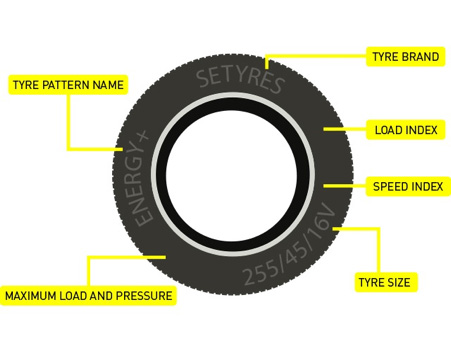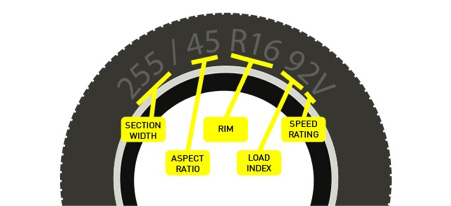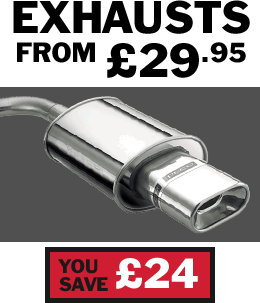Tyre Sidewall Markings Explained
The information printed around the sidewall of your tyre can tell you everything you need to know about your tyres. This information, however, is fairly difficult to read as it is mostly written in symbols, shorthand and codes. Fortunately, Setyres are on hand to help, and we've compiled a guide to explain your tyre sidewall markings and how important they are for you as a driver.
Tyre sidewall markings are predominantly used for two reasons. Firstly, they indicate the size and specification of the tyre and secondly, they indicate that the tyre has passed the necessary standards required to make it road safe and legal.
Tyre Brand / OE Tyre Markings
The manufacturer of the tyre will be clearly identifiable on the tyre sidewall.
To show that replacement tyres are meticulously crafted to meet the original exacting standards, an OE marking is embossed onto the tyre's sidewall. These markings serve as indicators of the specific car manufacturer for which the tyre has been meticulously designed.
For instance, tyres tailored for Audi vehicles bear the distinctive AO marking, while those destined for Mercedes vehicles showcase the MO designation. Similarly, BMW tyres feature the iconic star symbol. Each major vehicle manufacturer typically has its own unique sidewall marking to ensure precise compatibility.
OE tyres are the result of collaborative efforts between tyre manufacturers and vehicle makers. Notably, Setyres stands as a prominent figure in the OE realm, boasting hundreds of approvals from an extensive list of vehicle manufacturers.
Tyre Pattern Name
All tyre manufacturers have a range of tread patterns unique to their brand. The name given to the pattern of your tyre will be printed on the sidewall and often the range that your tyre has come from. This can be useful if you needed to replace your tyre and wanted to find a similar or identical tyre to replace it with.
Tyre Maximum Pressure
This figure indicates the maximum pressure that the tyre can withstand. You must not confuse this with the recommended inflation pressure suitable for every day driving. For more information on finding this figure, take a look at our advice about tyre pressure.
Tyre Size Explained
The tyre size is clearly printed along the tyre sidewall as a string of numbers. It will look something like this: 205/55/R18 105V. This indicates the sizes and dimensions of the tyre.
To explain this further:
205 is the tyre width in millimetres.
55 indicates the tyre sidewall height as a percentage.
R stands for radial construction.
18 displays the nominal diameter of the wheel rim that the tyre is designed to fit in inches.
Tyre Load Index
The load index is displayed following the string of numbers which are used to identify the sizes of the tyre: 205/55/R18 105V. This is a numerical code and relates to an amount in kilometres. The table below displays the load amounts that the codes indicate.
| Load Index | Kilograms | Load Index | Kilograms | Load Index | Kilograms |
|---|---|---|---|---|---|
| 65 | 290 | 80 | 450 | 95 | 690 |
| 66 | 300 | 81 | 462 | 96 | 710 |
| 67 | 307 | 82 | 475 | 97 | 730 |
| 68 | 315 | 83 | 487 | 98 | 750 |
| 69 | 325 | 84 | 500 | 99 | 775 |
| 70 | 335 | 85 | 515 | 100 | 800 |
| 71 | 345 | 86 | 530 | 101 | 825 |
| 72 | 355 | 87 | 545 | 102 | 850 |
| 73 | 365 | 88 | 560 | 103 | 875 |
| 74 | 375 | 89 | 580 | 104 | 900 |
| 75 | 387 | 90 | 600 | 105 | 925 |
| 76 | 400 | 91 | 615 | 106 | 950 |
| 77 | 412 | 92 | 630 | 107 | 975 |
| 78 | 425 | 93 | 650 | 108 | 1000 |
| 79 | 437 | 94 | 670 |
Tyre Speed Index
The speed index can be found after the load index on the tyre here 205/55/R18 105V. This letter indicates the maximum speed that the tyre can service and can be identified within the following table.
| Speed Symbol | Approx MPH |
|---|---|
| Q | 99 |
| R | 106 |
| S | 112 |
| T | 118 |
| H | 131 |
| V | 149 |
| VR | 131 |
| W | 168 |
| Y | 186 |
| ZR | 149 |
Higher Load Indexes & Different Speed Ratings
It might be feasible to install tyres with higher load indexes and differing speed ratings from those outlined in your vehicle's manufacturer documentation. However, it's crucial to initially consult your vehicle's manufacturer documentation to determine if these tyres are suitable for your vehicle and comply with local laws and regulations. You should adhere to all relevant requirements of local laws and regulations and refrain from surpassing the specifications of these tyres, as well as those stipulated in your vehicle's manufacturer documentation, regarding speed and load. Your dealer can assist you in verifying this before purchasing or installing tyres. You can read more about tyre speed ratings in our blog.
Can tyres with a higher speed rating than recommended by my manufacturer be fitted?
Yes, nevertheless, it's essential to first consult your vehicle's manufacturer documentation to ascertain if these tyres can be installed on your vehicle.
Can tyres with a higher load index than recommended by my manufacturer be fitted?
Yes, this might be feasible. Nonetheless, it's crucial to first consult your vehicle's manufacturer documentation to ascertain if these tyres can be installed on your vehicle.
Can tyres with both a higher speed rating and a higher load index than recommended by my manufacturer be fitted?
Yes, this might be possible. However, it's important to first consult your vehicle's manufacturer documentation to ascertain if these tyres can be installed on your vehicle.
Can tyres with a lower speed rating than recommended by my manufacturer be fitted?
Yes, you can utilise all-season or winter (M+S) tyres with a lower speed rating, provided that: a) a sticker displaying the maximum speed limit is within the driver's line of sight, and b) you adhere to the maximum speed limit. Nevertheless, it's essential to first consult your vehicle's manufacturer documentation to ascertain if these tyres can be installed on your vehicle.
Can tyres with both a higher load index and a lower speed rating than recommended by my manufacturer be fitted?
Yes, you can install tyres with a higher load index and a lower speed rating. You can employ all-season or winter (M+S) tyres with a lower speed rating, provided that: a) a sticker displaying the maximum speed limit is within the driver's line of sight, and b) you adhere to the maximum speed limit. Nonetheless, it's crucial to first consult your vehicle's manufacturer documentation to ascertain if these tyres can be installed on your vehicle.
Tread Wear Indicator
Tread wear indicators are present on many, but not all, tyres. The location of these indicators are highlighted by the letters TWI, except for on Michelin tyres which use the image of the Michelin man. The indicator will be set to at least 1.6mm, the minimum legal tread depth in the UK. When your tyre tread wears to reveal your tread wear indicator then it means you must have your tyres replaced. This is an emergency procedure and you should regularly check your tread depth to ensure that they do not drop too low. Take a look at how to check your tread depth here.
Mounting Direction
Tyre sidewalls are usually marked clearly with an indicator to show which way they should be mounted to the vehicle. This is because tyre tread and block have usually been designed to perform when travelling in a certain direction. Fitting tyres against the way that they were designed can lead to MOT failure.
European EC Type Approval Marks
The ‘EC’ marking proves that the tyre has been tested to European safety standards and has been approved. The ‘S’ symbol indicates sound and means that the tyre complies with EC noise directive.
If you have any questions regarding the symbols on your tyres or if you’re looking to buy new tyres, simply contact or visit your nearest Setyres branch.

















